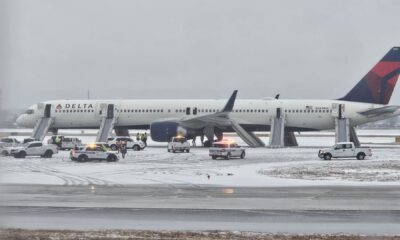Monday brought two rare events to Anchorage: the visit of a sitting U.S. president and the sight of an F-16 fighter jet flying low over the heart of the city, as it tried to get the attention of a person piloting a single-engine airplane that had entered restricted airspace.
The small plane, a Piper Super Cub, ended up landing at the Lake Hood airstrip after being circled by the NORAD fighter jet. President Joe Biden and other leaders left Anchorage without incident Monday afternoon after a 9/11 memorial held at Joint Base Elmendorf-Richardson.
When someone flies into a restricted area around a high-level government official or other sensitive location, NORAD — the North American Aerospace Defense Command — jumps into action, said NORAD spokeswoman Capt. Alexandra Hejduk. In this case, two F-16 fighter jets based at Eielson Air Force Base near Fairbanks were sent to Anchorage to intercept the Super Cub.
[F-16 fighter jet escorts small plane that entered closed airspace during Biden’s Anchorage visit]
The main purpose of the escort is to get the pilot of the plane to heed radio communications to safely leave the restricted airspace, Hejduk said. To accomplish that, they have to get the pilot’s attention.
First, they might try a maneuver — performed safely — called a “wing rock” or a “head butt,” which just means flying at a safe distance in front of the plane, she said. By then the pilot usually realizes it’s not normal to be tailed by a fighter jet and gets back on radio channels, where instructions to get out of the temporary flight restriction zone await. The main idea is to get the pilot to be in communication, Hejduk said.
“If they do that and the pilot still isn’t responding, they’d do a flare,” she said.
Many details about the Anchorage incident — including whether the incursion into restricted airspace Monday was unintentional or intentional — are not yet publicly known. But on Monday, the F-16 dispensed a flare to get the pilot’s attention somewhere “southeast of JBER,” according to NORAD.
:quality(70)/cloudfront-us-east-1.images.arcpublishing.com/adn/WX6R6VGTTNHT5EVBSE457PBRFU.jpg)
While a presidential visit means high security, temporary flight restrictions are not rare, said Hejduk. They can be enacted around all kinds of situations, such as wildfires and large events or military activities. NORAD is frequently called into service to enforce those restrictions.
“It’s our bread and butter,” Hejduk said.
It’s not clear where the Piper Super Cub was flying from on Monday, but the plane was escorted to Lake Hood, and met by airport police vehicles.
“The FAA will investigate and take appropriate action,” agency spokesman Rick Breitenfeldt said in an email Tuesday. “Generally speaking, pilots who violate (temporary flight restrictions) can face sanctions ranging from warnings to license suspensions or revocations.”
The name of the pilot has not been released. The FAA doesn’t comment on in-progress investigations, Breitenfeldt said.
Small-plane traffic around Anchorage is often heavy this time of year, with pilots coming and going from cabins, camps, fall hunts and elsewhere.
The situation sounds like a “pretty big blunder,” said Mark Phillips, a longtime Alaska pilot and the treasurer of the Alaska Airmen’s Association.
It “astounds me that it was over Anchorage,” because the city already has special FAA rules since the area is so dense with large and small airplanes, with five airports in the vicinity, he said.
No pilot wants to look out the window and see an F-16 trying to get their attention, Phillips said. The situation should be a reminder to pilots to know everything they can about restrictions before they take off, he said.
“It should be part of your pre-flight,” Phillips said.
• • •

:quality(70)/cloudfront-us-east-1.images.arcpublishing.com/adn/ME627E7VTBFXBJJQHB4C5VQM6U.jpg)























/cdn.vox-cdn.com/uploads/chorus_asset/file/25822586/STK169_ZUCKERBERG_MAGA_STKS491_CVIRGINIA_A.jpg)

/cdn.vox-cdn.com/uploads/chorus_asset/file/25821992/videoframe_720397.png)



